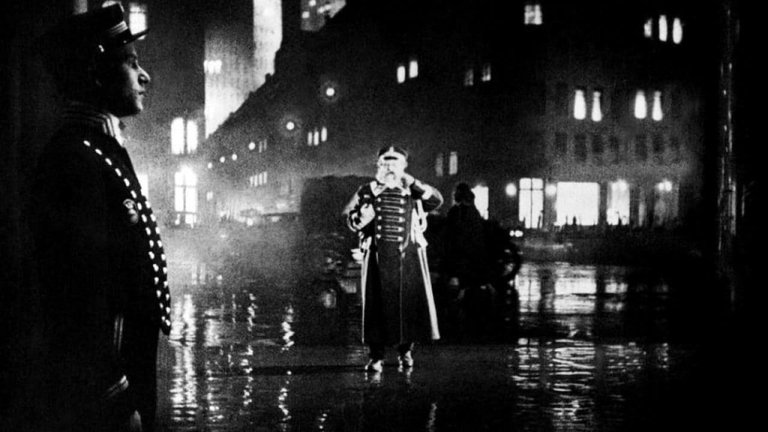Film Review: The Last Laugh (Der letzte Mann, 1924)

Many things have changed in past hundred years and one of them is the general attitude of people towards their respective jobs. At least, this is impression you might get if you compare Gen Z Tiktokers ranting about their jobs with the protagonist of The Last Laugh (originally The letzte Mann, literally “The Last Man”), 1924 drama directed by F. W. Murnau, one of the most important works of German and world’s silent cinema.
Emil Jannings plays unnamed doorman of Atlantic, the posh Berlin hotel. Being surrounded by glitz and glamour every day makes him not only happy, but very proud of his job. Nothing brings him joy more than returning to his dour working class neighbourhood while parading in doorman’s uniform, much to the delight of his beloved niece (played by Maly Delschaft), who is about to marry. His life comes crashing down when the hotel’s manager (played by Hans Unterkircher) tells him that he is considered too old and physically frail to hold his old job. Instead, he is to be reassigned to less demanding post of wash room attendant. He doesn’t take it well and, in desperation, even sneaks at night to steal his beloved uniform in order to wear it at niece’s wedding, only to be subjected to merciless mocking by friends and neighbours when his deception is revealed. He is about to end his days broken and humiliated, but unexpected and miraculously fortunate event allows him to return to the same hotel, but now as guest.
Friedrich Wilhelm Murnau is considered to be the greatest director of German silent cinema. He earned that reputation not only by groundbreaking quality of his work, but also through willingness to experiment with new themes and styles. While making The Last Laugh, Murnau, thanks to Nosferatu, was already established as one of Germany’s greatest film makers, closely associated with Expressionist movement. With this film he switched genres from fantasy and horror into realistic drama, or, more precisely, simple and seemingly less demanding form of “chamber drama film” (“Kammerspielfilm”). Story was relatively simple and easily relatable, which allowed renowned screenwriter and Murnau’s close associate Carl Mayer to use it for combination of social commentary and character study. But, despite its seemingly small scale, the film was actually quite ambitious project, made by German major studio UFA and shot almost entirely in its studios. This not only allowed Murnau to use studio’s large resources to reconstruct both the glitzy world of posh hotel and entire working class neighbourhood, but also to experiment with new techniques, which made The Last Laugh experimental, while at the same time very effective and almost ahead of its time. The most obvious departure from conventions was Murnau’s decision to abandon intertitles – which were the norm for silent films. There are some explanatory notes at the beginning, end and before epilogue, but The Last Laugh depends on viewers to interpret characters and plot by themselves, using only newspaper articles and official documents read by characters as convenient way of exposition. This works well, and Murnau shows how he had mastered the narrative language of film that would be later taken for granted. But even more impressive is work of cinematographer Karl Freund who has developed some of the early dolly techniques necessary to make scenes and character move according to principle that would later be known as “unchained camera”. Freund also experiments with lenses, creating powerful images of protagonist focusing on certain characters and details, or engaging in dream and fantasy, making The Last Laugh one of the films with the most subjective perspective by that time. Freund and Murnau achieved artistic triumph that they would later build on, culminating three years later in Sunrise, film which is viewed as the zenith of silent cinema.
The experimentation didn’t hurt The Last Laugh at the box office, and the reason is probably the same as the reason why it creates debates and controversy among hardcore cinephiles to this day. While Murnau and Mayer originally intended this drama to end in unhappy and realistic way, audiences in Weimar Germany, tired of so much misery in real life, wanted something different on screen and producer Erich Pommer decided to deliver it. He ordered happy ending and Murnau obliged, although the intertitle before the epilogue can be interpreted as disclaimer. The happy ending is well-directed and provides excellent opportunity for Emil Jannings to display his superb acting skills in broader ways, but for more perceptive and cynical viewers it still looks somewhat artificial and prolongs the experience. Despite those flaws, The Last Laugh is one of Murnau’s most lauded works. In 1955 West Germany it was remade as sound film starring Hans Albers and young Romy Schneider.
RATING: 7/10 (+++)
Blog in Croatian https://draxblog.com
Blog in English https://draxreview.wordpress.com/
InLeo blog https://inleo.io/@drax.leo
InLeo: https://inleo.io/signup?referral=drax.leo
Unstoppable Domains: https://unstoppabledomains.com/?ref=3fc23fc42c1b417
Hiveonboard: https://hiveonboard.com?ref=drax y
Bitcoin Lightning HIVE donations: https://v4v.app/v1/lnurlp/qrcode/drax
Rising Star game: https://www.risingstargame.com?referrer=drax
1Inch: https://1inch.exchange/#/r/0x83823d8CCB74F828148258BB4457642124b1328e
BTC donations: 1EWxiMiP6iiG9rger3NuUSd6HByaxQWafG
ETH donations: 0xB305F144323b99e6f8b1d66f5D7DE78B498C32A7
Posted using CineTV